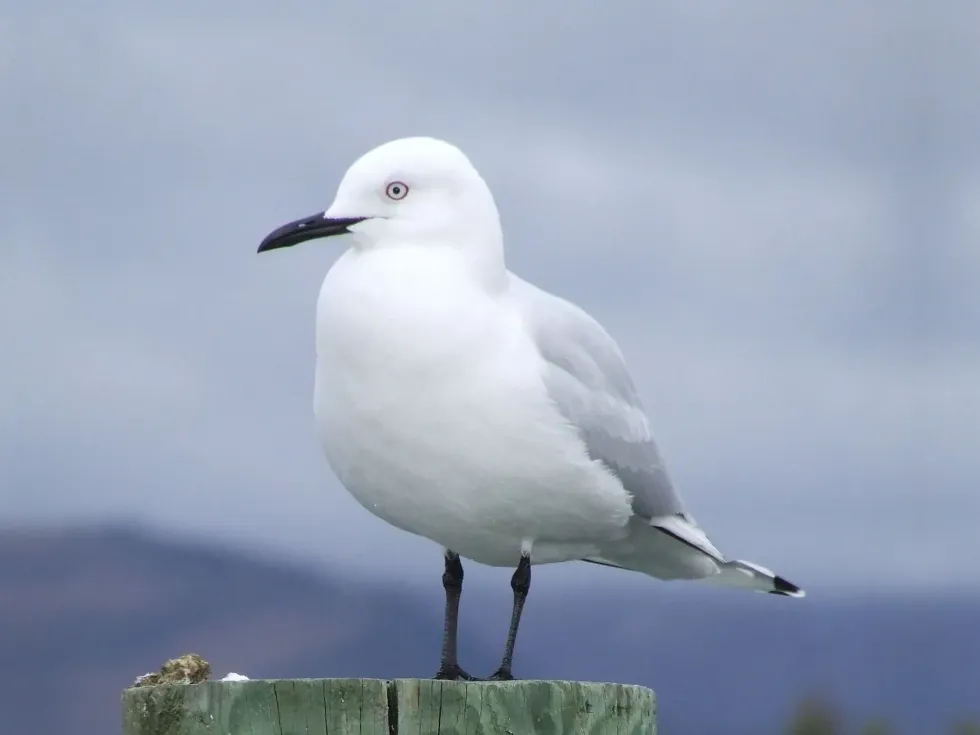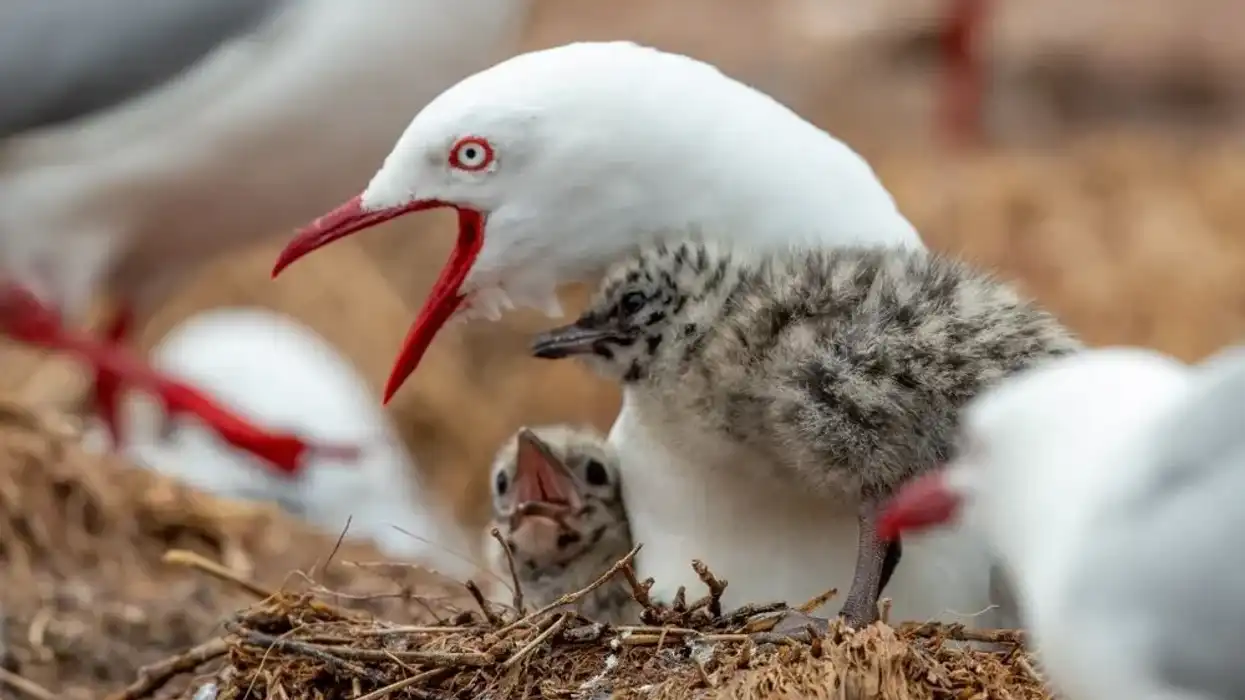Are you a bird lover and absolutely adore gulls like the glaucous gull or ring-billed gull, then you will be fascinated to know more about the black-billed gull. Found predominantly in the North Island and South Island of New Zealand, these are nationally critical birds.
These are magnificent birds that are are dull gray in color with black and white shades. However, the non-breeding birds slightly differ in the description, including the young ones that have brown plumes. Originally the legs are blackish-red in color.
However, they change into bright red during hatching. The breeding takes place in September after proper nesting takes place.
Once nesting is complete, then the eggs are laid. However, many eggs and chicks perish mainly due to the attack from the predators. After breeding, the birds migrate to coastal areas.
The coastal areas provide an abundance of food. The conservation status of these birds is currently Near Threatened as the population of the nesting sites is threatened by human disturbance.
In New Zealand that includes North Island and South Island, all types of gulls and terns are protected like the red-billed gull.
If you find our content interesting, then do check out our snowy plover facts and blue jay facts!
Black-Billed Gull Interesting Facts
What type of animal is a black-billed gull?
The black-billed gull (Chroicocephalus bulleri) is a bird species that belong to the Laridae family. This gull is thought to be one of the most endangered gulls due to the variety of threats it faces. The local name of this gull is tarāpuka.
What class of animal does a black-billed gull belong to?
Just like all other species of birds on our globe, the black-billed gull belongs to the class of Aves of the Animalia Kingdom like the glaucous gull or ring-billed gull!
How many black-billed gulls are there in the world?
The IUCN Red List estimates that there are approximately around 90,000-121,000 mature individuals that are present on the globe. This species has been listed as Near Threatened, and their population trend is currently unknown.
A number of factors are responsible for the slow decline in the population of this species which is edging towards extinction. These factors involve human activities like habitat loss, climate change, pollution, and other similar factors. Predation by other predatory birds, cats are also responsible for the decline of this species.
Where does a black-billed gull live?
Unlike the great black-backed gulls, the black-billed gull is species of gull that is endemic to New Zealand, meaning that these birds can only be found in New Zealand and no other place on Earth. The black-billed gull range is all over the island nation, frequently inhabiting the rivers, like the red-billed gull.
The breeding sites are usually on the north side of the island country, and in winter, these birds can be found on Snares Island.
Also, during the winter, the birds are generally more coastal by nature. Some places where they are found are the Opihi River, Orari River, Aparima River, and the Opuha Dam.
What is a black-billed gull's habitat?
The habitat of these birds has a wide range and includes numerous places like rivers, parks, lakes, lawns, and coastal areas. In the North Island of New Zealand, these birds frequent lakes and sandpits, while on the South Island, these birds are predominantly found on the braided river systems.
Who do black-billed gulls live with?
Black-billed gulls are highly social birds, and they live with one another in dense breeding colonies. There have been very limited recordings of these birds living together as isolated pairs. These birds are active nest builders and are known to change their nests annually both in the North and South Islands.
How long does a black-billed gull live?
In comparison with other birds of the world, the adult black-billed gull has quite a lengthy lifespan. These birds are known to live for almost 18 years on an average out in the wild; any sort of disturbance may shorter their lifespan.
How do they reproduce?
The breeding season commences from August when the male adult birds are seen to court the female birds. These adults are known to attain sexual maturity at about two years of age.
However, these adult birds usually breed at the age of three to four years. After the courtship is completed, nesting begins, and the colonies are all built by the middle of September.
The availability of food plays a vital role during the breeding season. Black-billed gulls in flight display soaring and swooping techniques is a very common sight during this period.
Adult pairs are known to use the same nesting sites for years where on average, two eggs are laid. The process of incubation is undertaken by both the male and the female adults, and it usually takes around 20-24 days before the hatchlings are finally born.
The nests are immediately emptied the following day when the hatchlings are born. When disturbed by predators and intruders, the flock escapes with the chicks whom the adults guard ferociously.
What is their conservation status?
The IUCN Red List has listed the black-billed gull as a species that is Near Threatened. Owing to very limited data on this species of birds, the population trend is currently unknown.
However, over recent years, the black-billed gull has been facing dangers of human disturbance in the form of habitat loss, climate change, and pollution. Proper conservation methods and steps are needed to be undertaken at the very earliest else; these amazing species of bird will surely end up in the jaws of extinction.
Black-Billed Gull Fun Facts
What do black-billed gulls look like?

These species of gulls can be easily identified mainly by their black border in the tail and a white wingtip. The black-billed gull wing is white, while the black bill is slender in size and helps in catching food. The body is of a dull gray hue, with the tail edges being black.
The iris is white, while the legs are reddish-black in color. Apart from the legs, the non-breeding adults have orange-black feet and black eyelids.
The young birds have partial black marks with brown patches on their plumes. The legs turn bright red during the process of hatching. Interestingly, during autumn and winter, they might have a dark gray patch on their body.
How cute are they?
These are extremely cute birds, and thus they are bound to be loved by one and all. Avian lovers and ornithologists are bound to find these birds to be extremely adorable and magnificent.
How do they communicate?
These birds are extremely social as well as loud and noisy. These birds interact with one another frequently as they live in large colonies. Interactions and chattering intensify during the breeding season between the mating pairs. Different calls like 'krrreh' and 'krrreeah' are often heard.
How big is a black-billed gull?
These birds measure 14-15 in (35.56-38.1 cm) approximately. In comparison with laughing gull 15-17 in (38-43 cm), we can say that the latter is slightly larger.
How fast can a black-billed gull fly?
Owing to very limited data and information, the exact speed at which these birds fly is currently unknown. However, we can make an assumption of their speed based on the flying speed of gulls. Seagulls are fast fliers, and they are known to fly at speeds ranging from 9.3-17.3 mph (15-28 kph) on average.
How much does a black-billed gull weigh?
These birds measure roughly around 6.7-9.5 oz (190–270 g) in weight. In comparison with the black-headed gull, at 0.6-0.7 lb (270-330 g) the latter is slightly heavier.
What are the male and female names of the species?
There are no sex-specific names for black-billed gulls. Just like all other birds, the males are called cocks, while the females are known as hens.
What would you call a baby black-billed gull?
Like all birds, baby black-billed gulls are known as chicks.
What do they eat?
These gull species are omnivorous animals, i.e., those who feed on both plants and animals. Though a substantial portion of the diet of these birds involves feeding on insects, small fishes, earthworms, and other smaller aquatic animals, these birds are also known to feed on wet grass when there is a scarcity of food.
These birds are extensive foragers and are also known to consume refuse.
Are they poisonous?
No, these gull species are not poisonous animals. Birds, in general, are non-poisonous animals, and that can also be said for the black-billed gull, which poses no harm to humans or other animals that live in their vicinity or share the same habitat.
Would they make a good pet?
Keeping these birds as a pet can be a bad choice for anyone. First of all, these are wild birds and thus inhabit riverine systems, and lakes act as their habitat mainly.
Secondly, these birds rarely stay alone and thus stays in colonies where a large number of individuals reside together. Lastly, the IUCN Red List has listed these birds under the Near Threatened category.
Thus it would be unwise or even illegal to have them as pets. Proper conservation and protection need to be undertaken; else these birds are bound to go extinct in the near future.
Did you know...
In the year 2018, for the Bird of the Year competition, the black-billed gull bagged 441 votes and was ranked in 30th place.
In New Zealand, they are considered Nationally Critical. This endangered status is mainly due to their declining numbers.
Do black-billed gulls migrate?
Yes, the black-billed gull is known to migrate on a relatively small scale. After the end of the breeding season, these birds are observed to migrate to the coasts from the South Island. However, owing to very little data and research, not much is known about their path, journey, or their route of migration.
Are black-billed gulls endangered?
The IUCN Red List has classified these birds under the Near Threatened category. The population trend of these birds has also been unknown over recent years.
However, the decline in their population is largely associated with various human disturbances. Destruction of habitat, climate change, pollution, and other factors are largely responsible for the decline in this species and are a major threat to them.
It is estimated that roughly around 90,000 - 121,000 mature individuals are present in today's world. Proper black-billed gull conservation steps and protection protocols should be implemented and followed at the very earliest else; this species is sure to go extinct in the coming years.
Here at Kidadl, we have carefully created lots of interesting family-friendly animal facts for everyone to discover! Learn more about some other birds from our swallow-tailed kite facts and canyon wren facts pages.
You can even occupy yourself at home by coloring in one of our free printable bird coloring pages.









